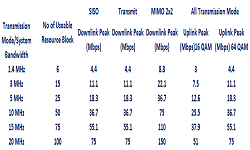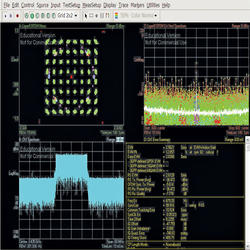LTE Layer 3 (RRC Layer) Interview Questions
4G LTE Layer 3 is an important layer includes RRC (Radio Resource Configuration) at UE and Base station. In this post is for L3 RRC interview questions with answers.
- What is difference between Acceptable, Suitable and Reserved Cell.
- How is state “Camped on Any Cell” different from “Any Cell Selection” state?
- What is CSG cell and CSG whitelist?
- Differentiate HPLMN, EHPLMN, RPLMN.
- What is Hybrid Cell?
- What is difference between Serving Cell and Primary Cell? How many Maximum Serving Cell can be there in total?
- Describe what does UE extract from the PBCH? How do we get to know about antenna Configuration from MIB?
- Describe what does UE get from tuning to PSS?
- Describe what does UE get from tuning to SSS?
- In brief describe (main parameters) what does UE get in SIB1?
- In brief describe what does UE get in SIB2?
- In brief describe what does UE get in SIB3?
- In brief describe what does UE get in PCCH?
- Where is MIB and SIB1 mapped in frame?
- Describe how do you get SIB2 to SIB13 info and periodicity?
- What is SI Modification Period? How do you get notified?
- After reading SI (System Information), what is the action by UE before Cell Selection? How does it get the input?
- What is Access Class.? What are special provides by AC 11 and 15?
- In which Idle states Emergency call is possible by AC 0 to 9?
- In Order to select a valid candidate PLMN, what is the minimum signal level(RSRP)? What is the minimum quality(RSRQ)?
- What is the “S” criteria. Specify the minimum value for candidate Cell.
- What is “R” Criteria. What is relation Q_hyst, Q_qualmin, & Q_rxlevmin.
- What are the triggers to make UE go from Idle to Connected mode?
- What is Registration? What are the triggers for Registrations?
- What is the difference between Intial and stored Info Cell (Re)Selection?
- What is SIntraSearchP? When will UE choose not to perform measurements in Intra-Frequency cells?
- What is SnonIntraSearchP? When will UE choose not to perform measurement in Inter-RAT/Inter-Freq cells
- What are the mobility states of UE?
- Where do you get T_cr_max, N_cr_H, N_cr_M? When will a mobile go to medium mobility state?
- What are the mobility scaling factors, sf-high and sf-medium? How do you use them?
- In Cell (re)Selection, what is the relation between Squal, ThreshX_HighQ and TreselectionRAT?
- What is Ranking and when will a UE initiate re-relection w.r.t. time, timer and measurement threshold?
- Compared to Non CSG cells, how is the reselection rule for a CSG cell?
- What is special in the re-selection from a CSG/Hybrid cell to non-CSG cell?
- What is the basic criteria to pass to initiate TA Registration?
- What is a PF (Paging Frame) and PO (Paging Occasion)?
- Except SI info, How else does eNB control UE Mobility in Idle Mode?
- What are the logical channels/Message types associated with SRB0, SRB1, SRB2, DRB and MRB?
- When UE reconfigures(deletes earlier value) a field(SRB, DRB etc..), the existing value is released except for during ?.
- What are the two (types of) messages there for BCCH in the DL-SCH?
- Can more than 1 SIB message be included in an SI message? Which ones and in what condition?
- How does the UE get the System Information of Serving Cells other than P Cell?
- How does an Relay Node acquire the System Information? Does it get it like UE Monitoring?
- When is MIB and SIB1 scheduled in a frame?
- How does UE know that there is a change in SI and it needs to monitor and read the SIBx?
- What are the triggers for UE to again Monitor the SI and read/update the values.
- When is Paging initiated?
- When is RRC connection establishment initiated?
- When is Initial security activation initiated?
- When is RRC connection reconfiguration initiated?
- When is Counter check initiated?
- When is RRC connection re-establishment initiated?
- When is RRC connection release initiated?
- When is RRC connection release requested by upper layers initiated?
- When is Radio resource configuration initiated?
- What are Radio link failure related actions initiated?
- What are UE actions upon leaving RRC_CONNECTED initiated?
- What are UE actions upon PUCCH/ SRS release request initiated?
- When is Proximity indication initiated?
- What are the 4 different RRC keys which change on every establishment or Handover?
- Describe briefly difference between Handover, Cell Change Order, CSFallBack and SRVCC.
- What are the entities added/deleted on SRB add/delete?
- What are the entities added/deleted on DRB add/delete?
- What are the entities added/deleted on SCell add/delete?
- In ASN.1, what is the difference between SEQUENCE, SET and CHOICE? Illustrate.
- Form a BCCH-MIB Binary Message with following Info:
BCCH-BCH-Message ::= SEQUENCE { message BCCH-BCH-MessageType }
BCCH-BCH-MessageType ::= MasterInformationBlock
MasterInformationBlock ::= SEQUENCE { dl-Bandwidth ENUMERATED { n6, n15, n25, n50, n75, n100},
phich-Config PHICH-Config,
systemFrameNumber BIT STRING (SIZE (8)), “assume 10101010”
spare BIT STRING (SIZE (10)) }
PHICH-Config ::= SEQUENCE { phich-Duration ENUMERATED {normal, extended}, phich-Resource ENUMERATED {oneSixth, half, one, two} }
Question# During Idle mode does UE have any E-RAB connection?
- Answer: During Idle mode UE have no E-RAB connection. E-RAB is established after RRC Connection.
Question# Which physical channel is responsible for paging indication?
- Answer: It’s not physical channel its paging control channel (PCCH)which is responsible for paging indication.
Question# What is different in simple CSFB and Flash CSFB?
- Answer: In simple CSFB we just have 3G frequencies but in Flash CSFB we have 3G frequencies and as well as Scrambling codes of 3G cells. RIM information let the UE know the SC of 3G.
Question# When UE do TAC LAC update?
- Answer: When UE do CSFB from LTE to 3G then once the call finish UE do LAC and TAC update.
Question#: In A3 if we increase the offset then it will delay the handover or it will make the handover faster?
- Answer: It increases the delay in HO.
Question#: MME is anchor point of which handover?
- Answer: S1 HO
Question#: Which entity take the handover decision either its UE, eNB or MME?
- Answer: for X2 eNB is responsible and for S1 MME is responsible.
Question: On which level UE location can be known to network like on cell level on eNB level, MME level or TAC level?
- Answer: TAC is responsible for the location of idle UE in the network.
Question: If you have E-RAB setup success failures what will you do?
- Answer: TNL drops, RNL drops, MME and failure in security commands cause ERAB setup failures.
Question: What is MOS (Mean Opinion Score)?
- Answer: IT is used to access voice quality and quality above 3.4 is considered as good MOS. It also depends on codec. Common used codec for NB (Narrowband) is 12.2kb/sec and WB (Wideband) are23.85KBkb/sec & 12.65kb/sec
Question: What is VoLTE?
- Answer: VoLTE is end to end packet call with delay less than 5sec. It involved IMS to handle packet call and has more good voice quality compared to UMTS and GSM.
Question: What is SRVCC?
- Answer: It is used for handling volte call on UMTS or GSM when LTE coverage is poor. In poor coverage Volte call makes handover to UMTS or GSM network.
Related Posts:
- 5G NR Layer 3- RRC Interview Question
- LTE Layer 1 (Physical Layer) Interview Questions
- LTE Layer 2 (MAC,RLC,PDCP) Interview Questions
- LTE Layer 3 (RRC Layer) Interview Questions



